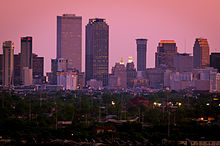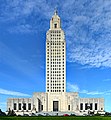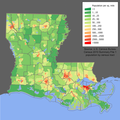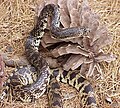Portal:Louisiana
The Louisiana Portal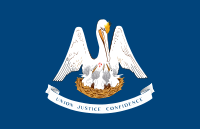 Louisiana (French: Louisiane [lwizjan] ⓘ; Spanish: Luisiana [lwiˈsjana]; Louisiana Creole: Lwizyàn) is a state in the Deep South and South Central regions of the United States. It borders Texas to the west, Arkansas to the north, and Mississippi to the east. Of the 50 U.S. states, it ranks 20th in land area and the 25th in population, with roughly 4.6 million residents. Reflecting its French heritage, Louisiana is the only U.S. state with political subdivisions termed parishes, which are equivalent to counties, making it one of only two U.S. states not subdivided into counties (the other being Alaska and its boroughs). Baton Rouge is the state's capital, and New Orleans, a French Louisiana region, is its largest city with a population of about 383,000 people. Louisiana has a coastline with the Gulf of Mexico to the south; a large part of its eastern boundary is demarcated by the Mississippi River. Much of Louisiana's lands were formed from sediment washed down the Mississippi River, leaving enormous deltas and vast areas of coastal marsh and swamp. These contain a rich southern biota, including birds such as ibises and egrets, many species of tree frogs—such as the state recognized American green tree frog—and fish such as sturgeon and paddlefish. More elevated areas, particularly in the north, contain a wide variety of ecosystems such as tallgrass prairie, longleaf pine forest and wet savannas; these support an exceptionally large number of plant species, including many species of terrestrial orchids and carnivorous plants. Over half the state is forested. Louisiana is situated at the confluence of the Mississippi river system and the Gulf of Mexico. Its location and biodiversity attracted various indigenous groups thousands of years before Europeans arrived in the 17th century. Louisiana has eighteen Native American tribes—the most of any southern state—of which four are federally recognized and ten are state recognized. The French claimed the territory in 1682, and it became the political, commercial, and population center of the larger colony of New France. After a brief period of Spanish rule, Louisiana was returned to France in 1801 before being purchased by the U.S. in 1803; it was admitted to the Union in 1812 as the 18th state. (Full article...) Entries here consist of Good and Featured articles, which meet a core set of high editorial standards.
The state of Louisiana has 38 state parks, which are governed by the Office of Lieutenant Governor, a division of the Louisiana Department of Culture, Recreation and Tourism. Louisiana's state park system began in 1934 when the state passed legislation that created the State Parks Commission of Louisiana. In 1952, legislation broadened the role of the commission to include the development of outdoor recreation programs and resources. The commission was renamed to the Louisiana State Parks and Recreation Commission. In 1977, the Office of State Parks was created in the Department of Culture, Recreation, and Tourism. After the State Parks Commission of Louisiana was formed in 1934, 7 sites were acquired for use as state parks. During World War II, the rate of new park acquisition declined with the addition of only one new site, Sam Houston Jones State Park in 1944. In 1966, the National Park Service reviewed Louisiana's state parks system and made many recommendations, which led to specific guidelines and requirements for state parks. Over time, many state parks that did not meet these guidelines were either reclassified as state historic sites or were turned over to local or state agencies. Some of these parks include Lac des Allemands, Saline Bayou, and Black Lake. During the 1970s, government management of the state parks was restructured. The Office of State Parks was created, and 2 new parks were acquired. From 1995 to 2009, $80 million were invested in creating new facilities, or updating existing facilities. (Full article...)Selected article -New Orleans (commonly known as NOLA or the Big Easy among other nicknames) is a consolidated city-parish located along the Mississippi River in the southeastern region of the U.S. state of Louisiana. With a population of 383,997 according to the 2020 U.S. census, it is the most populous city in Louisiana and the French Louisiana region; third most populous city in the Deep South; and the twelfth-most populous city in the southeastern United States. Serving as a major port, New Orleans is considered an economic and commercial hub for the broader Gulf Coast region of the United States. New Orleans is world-renowned for its distinctive music, Creole cuisine, unique dialects, and its annual celebrations and festivals, most notably Mardi Gras. The historic heart of the city is the French Quarter, known for its French and Spanish Creole architecture and vibrant nightlife along Bourbon Street. The city has been described as the "most unique" in the United States, owing in large part to its cross-cultural and multilingual heritage. Additionally, New Orleans has increasingly been known as "Hollywood South" due to its prominent role in the film industry and in pop culture. (Full article...)General images -The following are images from various Louisiana-related articles on Wikipedia.
Did you know -
Related portalsTopicsCategoriesNew articlesThis list was generated from these rules. Questions and feedback are always welcome! The search is being run daily with the most recent ~14 days of results. Note: Some articles may not be relevant to this project.
Rules | Match log | Results page (for watching) | Last updated: 2024-05-05 20:37 (UTC) Note: The list display can now be customized by each user. See List display personalization for details.
WikiProjectsTasks
Associated WikimediaThe following Wikimedia Foundation sister projects provide more on this subject:
SourcesDiscover Wikipedia using portals |

